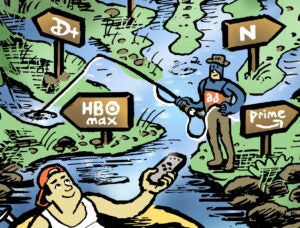“On TV And Video” is a column exploring opportunities and challenges in advanced TV and video.
Today’s column is written by Clair Bergam, associate director at The Media Kitchen.
At a time when dismal numbers dominate the national conversation, one of the few exceptions are those being generated by the TV and over the top (OTT) market. As consumers continue to stay at home, OTT vendors are seeing unprecedented audience and consumption trends.
Pre-COVID, such trends would have brands licking their chops to get into the market. But today’s dire circumstances should cause marketers to press the pause button (if only for a moment) to figure out just how to react.
Nearly every TV medium is getting a boost
Every acronym in the space – AVOD, SVOD, TVOD, you name it – is seeing an increase in audience numbers and viewing time. Through the first three weeks of March, the total estimated number of minutes streamed on TV was 400 billion, according to Nielsen, an increase of 85% compared with the same three-week period in 2019. New subscribers have skyrocketed on platforms that were previously speculated as reaching a plateau (ahem, Netflix).
Consumption-wise, viewers are shifting from sports to news and “escape” media, and publishing companies are doing their best to make these opportunities known to advertisers.
In short, a hunkered-down audience and subsequent inventory has increased by leaps and bounds over the last several weeks, creating an interesting dichotomy in the marketplace as many advertisers scale back their media investments due to budget cuts. At the same time, no company wants to be perceived as taking advantage of this global tragedy.
Marketers: Take a breath, then quickly pivot
It’s natural and perhaps necessary for brands to take a moment to reevaluate their messaging right now, but what’s more important is that they find a way to quickly pivot and reintroduce themselves with messaging that proves cognizant of the current situation.
As brands navigate this crisis, there’s a fine line between maintaining a presence on channels such as OTT and being responsive to the current global crisis. Research from Kantar found a six-month absence in TV advertising could result in a 39% reduction in total brand awareness. Kantar also found 72% of consumers said they felt brands should be informing the public about their efforts to combat the current situation. Brands should consider how they can thoughtfully communicate how they are responding to the crisis as a means of both maintaining a presence and communicating their truest values to consumers.
Once brands refine their messaging, they should consider how the current trends in OTT viewing have affected their typical audience viewing habits. For instance, some research shows sports viewers have flocked toward news and reality TV in the absence of live sports. Generally, viewers seem to be consuming more cheerful and humorous content as a form of escapism – and aside from news content, the kids and family genre is seeing the largest spike in viewership with family-viewing time on the rise.
Marketers should also stay on top of the continuing streaming wars and recent launches of Quibi and Peacock to understand how consumer behavior is evolving with these new players in the space.
All of these trends can and should be used to inform current and upcoming OTT plans as brands react to shifting consumer behaviors and trends.
This pandemic will have lasting effects on TV viewing habits. Streaming is replacing major motion picture releases. The one thing tethering many cable users to their subscriptions – live sports – has disappeared. And, consumers facing economic hardships will look to their litany of streaming services first as a place to cut back.
The bottom line
While it may be tempting to look at the current boom in OTT as a major win for TV and marketers, it’s important to remember it’s an opportunity to fail as much as it’s an opportunity to succeed. Marketers need to be careful as they navigate the COVID-19 landscape and beyond. Whether these pandemic-induced shifts in consumer behavior turn into long-term trends remains to be seen.
What is clear, however, is that consumers’ priorities and values have indeed changed, and it’s incumbent on marketers to recognize these changes and respond thoughtfully and accordingly.
Follow The Media Kitchen (@themediakitchen) and AdExchanger (@adexchanger) on Twitter.














